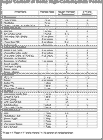
Diabetes: Constant Carbohydrate Meal Plan
What is the constant carbohydrate meal plan?
The constant carbohydrate meal plan is a food program that will help balance the amount of carbohydrates your child eats each day. Carbohydrates affect your child's blood sugar more than any other kind of nutrient. Insulin works with carbohydrates to supply energy for the body. It is important to keep insulin and carbohydrates in balance. Consistency is the key to this meal plan. The constant carbohydrate meal plan is the food program that many people start with when they are diagnosed with diabetes.
How is this plan different from the exchange meal plan?
The exchange meal plan is not as commonly used as the constant carbohydrate plan. The constant carbohydrate plan is different from the exchange meal plan because you only keep track of carbohydrates rather than keeping track of all food types. The constant carbohydrate plan is more flexible, but may not be as healthy as the exchange diet if you are not careful about your food choices.
How does the constant carbohydrate plan work?
Your child needs to eat a consistent amount of carbohydrates at each meal during the day. Your dietitian will tell you how many carbohydrates your child can eat based on the number of calories your child needs each day. Carbohydrates are found in many of the different types of food. You count carbohydrates in portion sizes of 15 grams. A serving of 15 grams of carbohydrate is called a "carb choice." You can tell how much carbohydrate is in a food by reading the nutrition label on the food package.
What foods contain carbohydrates?
Food groups that contain carbohydrates are:
Starch (breads, cereals, rice, pasta, and starchy vegetables)
Some examples of 1 carb choice (15 grams):
- 1 slice bread
- 1/2 cup pasta
- 1/2 cup peas
- 1/3 cup cooked rice
- 1/3 cup cooked beans.
Fruits
Some examples of 1 carb choice (15 grams):
- 1 small size piece of fruit
- 1/2 cup of canned fruit (in its own juice)
- 1/2 cup fruit juice
- 1/4 cup dried fruit.
Milk and yogurt
Some examples of 1 carb choice (15 grams):
- 1 cup milk
- 3/4 cup plain low-fat yogurt.
Sugary foods
Sweets should be eaten in smaller amounts for a healthy diet. Sugar is a carbohydrate. Portion sizes vary depending on the item. One tablespoon of sugar equals one carb choice. One serving of sweets may equal 2 or more carb choices. You can read the nutrition facts on the back of package labels to check how many grams of carbohydrate are in the item. You can also use the Exchange List for Meal Planning to check how many carb choices are in different items. This booklet is available from The American Diabetes Association and the American Dietetic Association (1-800-342-2383). Although this book is often used for the exchange diet, it lists the carbohydrate content for lots of foods and is very useful.
What about meat, fats, and vegetables?
Although these foods are important in your diet, they do not affect your child's blood sugar in the same way that carbohydrates do. However, these foods do count toward your daily calories, so you need to be careful not to eat too much fat and eat healthy.
- Vegetables such as lettuce, carrots, and celery do not count toward your child's daily carbohydrates, but they should be eaten every day as part of a healthy diet.
- Meats are protein. Although they do not count as carbohydrates, they do contain fat and calories. Your child should eat meat in moderation.
- Fats such as butter, salad dressing, mayo, bacon, and cream should also be eaten sparingly.
How many calories should my child eat a day?
A dietitian will help you plan how many carb choices your child should eat during the day based on the number of calories your child needs per day. Most children under age 14 need 1000 calories per day plus 100 calories for each year of age.
1000 calories + (# of years x 100 calories) = # of calories needed per day
For example, a 5-year-old would need 1500 calories.
1000 calories + (5 years x 100 calories) = 1500 calories/day
How many carb choices should my child eat at each meal?
Your dietitian will help you come up with a plan that is right for your child. In general, the following table lists the approximate number of carb choices that should be eaten at each meal during the day based on how many calories your child needs per day.
1200 1500 1800 2000 2200 2500
cal. cal. cal. cal. cal. cal.
----------------------------------------------------------
Breakfast 3 3 4 4 5 7
10:00 am 1 1 1 1 1 1
Snack
Lunch 2.5 3 4 5 6 6
3:00 pm 1 1 2 2 2 3
Snack
Dinner 2 4 3 4 5 6
9:00 pm 1 1 1 1 1 2
Snack
----------------------------------------------------------
The amount of food eaten at a meal or snack may need to vary with factors such as expected exercise, insulin dose, and blood sugar level. More food may be needed when your child plans to exercise. However, the normal eating pattern of the child and the family should stay the same as much as possible.


